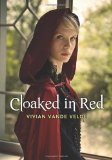
Review posted June 2, 2012.
Marshall Cavendish, 2010. 127 pages.
I loved Vivian Vande Velde's The Rumpelstiltskin Problem, so I made sure to snap up Cloaked in Red when I heard about it.
In both books, she takes a fairy tale you thought you knew, and casts it in a very different light. Okay, several different lights. She looks at the story from many different perspectives.
Her Author's Note at the beginning makes some fun points:
There are different versions, but they all start with a mother who sends her daughter into the woods, where there is not only a wolf, but a talking, cross-dressing wolf. We are never told Little Red Riding Hood's age, but her actions clearly show that she is much too young, or too dimwitted, to be allowed out of the house alone.
Or how about the heroine's unusual name?
And what happened later in life, when Little Red Riding Hood was no longer little? Did she shift to "Medium-Sized Blue-Beaded Sweater"? Did she eventually become "Size-Large and Yes-That-DOES-Make-Your-Butt-Look-Enormous Jeans"?
I love the way she points out how unlikely it all is. Here's Red in the cottage:
I don't like to criticize anyone's family, but I'm guessing these people are not what you'd call close. Little Red doesn't realize a wolf has substituted himself for her grandmother. I only met my grandmother three times in my entire life, but I like to think I would have noticed if someone claiming to be my grandmother had fur, fangs, and a tail.
But Little Red, instead of becoming suspicious, becomes rude.
"My," she says -- as far as she knows -- to her grandmother, "what big arms you have."
Big she notices. Apparently hairy and clawed escape her.
Vivian Vande Velde concludes her introduction with these words:
However you look at it, "Little Red Riding Hood" is a strange and disturbing story that should probably not be shared with children.
That is why I've gone ahead and written eight new versions of it.
The eight stories that follow are amazingly varied, even though you can see how they relate to the fairy tale. These ones seemed darker to me than the ones in The Rumpelstiltskin Problem, but then "Little Red Riding Hood" is a quite dark and violent tale.
We've got one from the perspective of pretty much every one in the story. I like the one where Jakob and Wilhelm, the dimwitted Grimm brothers, sons of a woodcutter, misunderstand when Grandma's talking about making a wolf draft-stopper for her granddaughter. My favorite is probably the one about the nice wolf who is trying to be helpful after an annoying little girl steps on his tail, screams, and drops her basket.
The wolf inhaled deeply the tantalizing smells of meat and baked goods, and was strongly tempted to gobble everything up. But his mother had raised him better than that.
"Little girl!" he called after the fleeing child. He could no longer see her, though her shrieks trailed behind her like a rat's tail. "You forgot your food!"
Apparently the little girl could not understand wolf speech any more than the wolf could understand human speech, since she didn't come back.
If the wolf hadn't had such a deeply held moral belief system, he could have convinced himself that by leaving the basket behind, the girl had forsaken her rights to it. But, instead, he picked up the basket in his teeth, then loped through the trees, following the trails of wailing, crushed forest vegetation and human scent.
Reading this book makes me want to try my hand at rewriting fairy tales. Above all, all the variations are clever and inventive and a nice exercise in how point of view changes a story.

